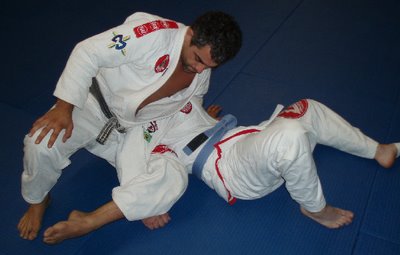
The always excellent GrappleArts.com Grappling Tip of the Week - Reverse Omo Plata. Check it out...
 Sam explained it this way - "I was pushing you away to get room to kick, then got pulled into the knee!" I didn't remember how this happened at the time, just that all of a sudden my knee hurt! I checked the tape and found this. It still hurts a little from almost a week ago. I made contact on the quadriceps, just above my knee pad and hit his forehead.
Sam explained it this way - "I was pushing you away to get room to kick, then got pulled into the knee!" I didn't remember how this happened at the time, just that all of a sudden my knee hurt! I checked the tape and found this. It still hurts a little from almost a week ago. I made contact on the quadriceps, just above my knee pad and hit his forehead.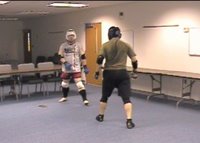
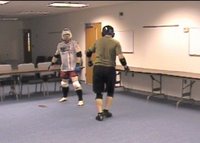
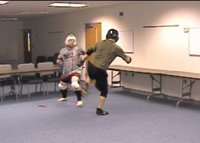
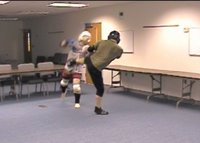
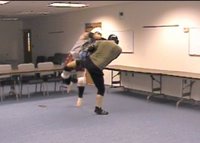
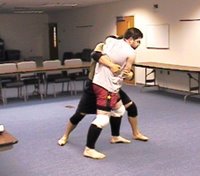


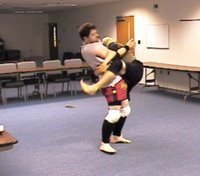
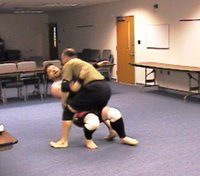

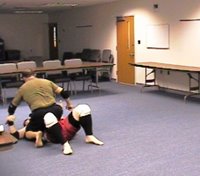
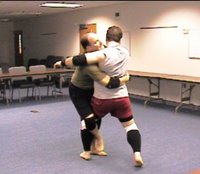
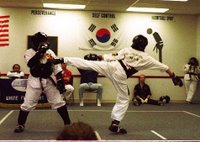 I love Hock Hockheim's thinking on conceptual matters relating to training philosophy. For example, in his blog post for April '06 titled "Pushing the Envelope," he iterates a position on training that I have always espoused, that you should train for perfection so that you'll get as close as possible.
I love Hock Hockheim's thinking on conceptual matters relating to training philosophy. For example, in his blog post for April '06 titled "Pushing the Envelope," he iterates a position on training that I have always espoused, that you should train for perfection so that you'll get as close as possible.
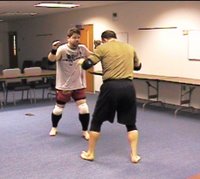 Close the gap using the wedge block
Close the gap using the wedge block Drive your forehead into the middle of the chest, grasping the biceps on each side
Drive your forehead into the middle of the chest, grasping the biceps on each side Look toward the left arm, then wrap it, pulling it up tightly under your armpit
Look toward the left arm, then wrap it, pulling it up tightly under your armpit Simultaneously step around toward your right and raise your right elbow up, driving up your partner's arm
Simultaneously step around toward your right and raise your right elbow up, driving up your partner's arm Wrap your right arm around your partner's waist. Remember to keep your head tucked.
Wrap your right arm around your partner's waist. Remember to keep your head tucked.
 "American Wrestling vs. Jujitsu" is an old article from the Journal of Combative Sport. I mean really old - "This article originally appeared in the May 1905 issue of The Cosmopolitan." This is an interviewer's attempt to compare and contrast the Japanese art of Jujitsu with the American form of wrestling being taught at the time. I am sure that there was a great deal of mystery about any of the "Oriental" arts at that time. You may remember that this was during the presidency of Theodore Roosevelt, and during this time, the Empire of Japan was just coming out of fuedalism and was being forced to open itself up to the West. The mysterious arts were only becoming known by rumor and via famous exponents like President Roosevelt himself (Judo).
"American Wrestling vs. Jujitsu" is an old article from the Journal of Combative Sport. I mean really old - "This article originally appeared in the May 1905 issue of The Cosmopolitan." This is an interviewer's attempt to compare and contrast the Japanese art of Jujitsu with the American form of wrestling being taught at the time. I am sure that there was a great deal of mystery about any of the "Oriental" arts at that time. You may remember that this was during the presidency of Theodore Roosevelt, and during this time, the Empire of Japan was just coming out of fuedalism and was being forced to open itself up to the West. The mysterious arts were only becoming known by rumor and via famous exponents like President Roosevelt himself (Judo)."I say with emphasis and without qualification that I have been unable to find anything in jujitsu which is not known to Western wrestling. So far as I can see, jujitsu is nothing more than an Oriental form of wrestling. It is a boast of the exploiters of jujitsu that through it any weakling could render helpless even a well-trained athlete, and that, too, without inflicting any injury whatever upon the victim. It would be an entertaining day in my life indeed were I to see such a feat accomplished." – Statement by Mr. Leonard after exhibition by Mr. Higashi.No doubt, they've both got points, but it's both interesting and sad that these statements could've still been made today and are typical of the myths that surround the old style versus stlyist arguments that still go on today (in other words, which is the superior style, or is it the fighter). Read it all. Hilarious, entertaining, and informative.
"American wrestlers are strong – much stronger than any of us pretend to be in muscular strength. After all, however, wrestling is wrestling. Against jujitsu it is mere child’s-play. I have met a number of Western wrestlers, and they are as helpless as babes against the art of jujitsu. And no one versed in the art of jujitsu is mad enough to expect anything else." – Statement by Mr. Higashi after exhibition by Mr. Leonard.

 Sammy Franco, of Contemporary Fighting Arts now has a blog. I don't know a lot about him, but like what I've read so far. Check out his blog here, or look for it as a new Link (see sidebar).
Sammy Franco, of Contemporary Fighting Arts now has a blog. I don't know a lot about him, but like what I've read so far. Check out his blog here, or look for it as a new Link (see sidebar).






What this illustrates is that you need to be confident in fighting in each of these ranges:
Kicking, punching/striking, Clinching/infighting. Then of course, grappling.
 As you may know the newest US Army Field Manual on combatives (as defined by the manual, "... an engagement between two or more persons in an empty-handed struggle or with hand-held weapons such as knives, sticks, or projectile weapons that cannot be fired.") contains a large proportion of techniques derived from Brazilian Jiu-Jitsu. It's here that the Martialist article by Phil Elmore has the body of his criticism. His opinion, "I am sad to say that FM 3-25.150 is a dreadful manual, the curriculum in which is an unrealistic and impractical marriage of Brazilian Jiu-Jitsu (BJJ) to battlefield combatives."
As you may know the newest US Army Field Manual on combatives (as defined by the manual, "... an engagement between two or more persons in an empty-handed struggle or with hand-held weapons such as knives, sticks, or projectile weapons that cannot be fired.") contains a large proportion of techniques derived from Brazilian Jiu-Jitsu. It's here that the Martialist article by Phil Elmore has the body of his criticism. His opinion, "I am sad to say that FM 3-25.150 is a dreadful manual, the curriculum in which is an unrealistic and impractical marriage of Brazilian Jiu-Jitsu (BJJ) to battlefield combatives."The practicality is also criticized:
On the other hand, for learning, BJJ without a qualified instructor, as I am, you'd probably be hard-pressed to find a better source than what is contained in the manual. I agree with Elmore as far as the needs of an infantryman on the battlefield, but for civilians like me, it's a great text for filling in the groundfighting gaps in our training.
Day, Date, Time: | Participants: |
Saturday, 04/22/2006 | Nathan, Sam, Mike |
All gear required – including knee pads on 4/22 | |
Group Training Objectives | Training Agenda |
Review: | 1. Warm-up 2. Review Falling to rear [5-1] 3. Fall to Prone Defensive Position drill vs. shield 4. Teach Clinch [5-2] 5. Sucker punch to clinch [5-2] 6. Shove & punch to clinch [5-2] 7. Basic takedown to Mount [5-3], then with leg hook 8. Demonstrate Clinch, takedown, mount vs. Sucker punch 10. Sparring, hands versus feet 11. Wrestling in Thai Clinch |
· Falling to rear [5-1] · Prone defensive position · Sucker punch · shove & punch | |
Teach: | |
· Clinch [FM 3-25.150 5-2] Done · Basic Takedown to mount [5-3] Done | |
Demonstrate: | |
· Clinch, takedown, mount vs. Sucker punch | |
Action Items – Nathan | |
· Vigilant when in range · Simultaneous slip & counter, or stop-hit · Stance on the balls of the feet · Keep the lead aimed! - Circle! Practice what you preach there. · CLEAR more consistently. Plan it before you close the gap · Check in close · Palms to the chin (infighting upward) · Incorporate grabbing and striking | |
Action Items – Sam | |
· Always keep your guard in the way of what can hit you – it'll change depending on range and angle · Stay in, or always return to, your base fighting stance, you're getting hit when you're out of it · Clear to the side or in at a 45-degree angle; Clear behind the opponent · Work on smooth integration of kicks, strikes, infighting (knees & elbows), trapping, then grappling · Drill defensive kicking as a counter/stop-hit · Work on footwork while moving to your right you step and slide well to the left, but not the right! · Fire through the target with the rear-hand – this is improving a lot, per the tapes. Keep it up! | |
Action Items – Mike | |
· Fake and feint A LOT. Double and triple every lead hand. · Work your combinations (inside/outside, high/low) · Kick constantly. Stretch as much as you can. · Exhale and tense the abs when getting hit to the body · Your guard is down when you're leading · Turn in the hip for the Thai Kick, and work on the front kick a lot | |
· Learn more basic offensive striking techniques · Learn basic defenses- Parry, blocking, catch, roll, cut · Aim the lead hand so that you telegraph less. · Work some rounds on defense only · Move in circles (instead of straight back) on defense | |
 It's rarely mentioned in media reports, but guns are used over a million times a year to prevent crimes and save lives. Women, usually considered among the most vulnerable to violence, are many times the beneficiary of a weapon used in self-defense. Read about a woman who was about to be murdered, and used a gun to save her own life.
It's rarely mentioned in media reports, but guns are used over a million times a year to prevent crimes and save lives. Women, usually considered among the most vulnerable to violence, are many times the beneficiary of a weapon used in self-defense. Read about a woman who was about to be murdered, and used a gun to save her own life.This brave woman did several things right:A 28-year-old Clermont County woman woke up Monday morning to find a man pointing a gun at her face.
That man was her ex-boyfriend, and what she was able to do in the minutes that followed may have saved her life.
But this would be victim was able to turn the tables on her attacker.
It's the attacker now who is at University Hospital after suffering a shotgun blast
to his legs.
Cassandra Gray knows she's lucky to be alive. "He told me to get dressed, I was going with him and he was gonna kill both of us," Gray told 9News.
With that man, 32-year-old Gary Glass, her ex-boyfriend, pointing a gun at her face she knew she had to stall for time.
"That's the only thing I kept thinking, I'm not going with him, not going because I won't come back," said Gray.Her dogs were barking so she convinced Glass to let her let them outside.
She says she then talked to Glass for several minutes, and then, let the back in.
That's when she grabbed the phone to call 911 and they started wrestling.
"My dogs attacked him and he laid the gun down," said Gray.
"I grabbed the gun and ran and fell," said Gray, "and as I fell I rolled and he was coming toward me and I picked up the gun and shot."
Way to go, lady!
Different reputable sources inform us that you don't need to do cardio -- just spar really long rounds (for grappling), or that you should spar twice as many rounds as you are going to fight (boxing), or that you should do sprints, or do long runs, or lift weights for muscular endurance, etc. With so many 'experts', it is no wonder that the answer isn't cut and dried.
I have my own beliefs and they seem to work fairly well for me. I noticed a couple of years ago that my techniques worked best and my sparring was sharpest not when I was stronger but rather when my 'cardio' was at its peak. Because I wasn't getting winded in sparring, I was able to think and make coherent plans throughout the match. At the time I was running 3 or 4 times a week, for 20 to 50 minutes at a time in preparation for the fire department entrance test.
The more research I have done on running, the more I have come to realize that there are different levels of intensity for cardio and that it is important to spend quality time in most of them. It is probably true that one could substitute wrestling, uchikomi, kicking the bag/pads, or sparring for 'traditional' exercises, and that they would develop more sport-specific skills. I do a lot of running, biking, stairmastering or stair running, however, because of 4 reasons...
US Marine Corps Rules:
1. Be courteous to everyone, friendly to no one.
2. Decide to be aggressive ENOUGH, quickly ENOUGH.
3. Have a plan.
4. Have a back-up plan, because the first one probably won't work.
5. Be polite. Be professional. But, have a plan to kill everyone you meet.
6. Do not attend a gunfight with a handgun whose caliber does not start with a "4."
7. Anything worth shooting is worth shooting twice. Ammo is cheap. Life is expensive.
8. Move away from your attacker. Distance is your friend. (Lateral & diagonal preferred.)
9. Use cover or concealment as much as possible.
10. Flank your adversary when possible. Protect yours.
11. Always cheat; always win. The only unfair fight is the one you lose.
12. In ten years nobody will remember the details of caliber, stance, or tactics. They will only remember who lived.
13. If you are not shooting! , you should be communicating your intention to shoot.
Navy SEALS Rules:
1. Look very cool in sunglasses.
2. Kill every living thing within view.
3. Adjust speedo.
4. Check hair in mirror.
US Army Rangers Rules:
1. Walk in 50 miles wearing 75 pound rucksack while starving.
2. Locate individuals requiring killing.
3. Request permission via radio from "Higher" to perform killing.
4. Curse bitterly when mission is aborted.
5. Walk out 50 miles wearing a 75 pound rucksack while starving.
US Army Rules:
1. Select a new beret to wear.
2. Sew combat patch on right shoulder.
3. Change the color of beret you decide to wear.
US Air Force Rules:
1. Have a cocktail.
2. Adjust temperature on air-conditioner.
3. See wh! at's on HBO.
4. Ask "what is a gunfight?"
5. Request more fund ing from Congress with a "killer" PowerPoint presentation.
6. Wine & dine 'key' Congressmen, invite DOD & defense industry executives.
7. Receive funding, set up new command and assemble assets.
8. Declare the assets "strategic" and never deploy them operationally.
9. Hurry to make 1345 tee-time.
US Navy Rules:
1. Go to Sea.
2. Drink Coffee.
3. Watch porn.
4. Deploy the Marines
 In this USADojo.com article , "Close Encounters of the Wrong Kind," women's self-defense authority Melissa Soalt explains that, "Predators often use engulfing, pinning, choking, slapping or immobilizing tactics..." In other words, infighting. She shares details of an attempted sexual assault:
In this USADojo.com article , "Close Encounters of the Wrong Kind," women's self-defense authority Melissa Soalt explains that, "Predators often use engulfing, pinning, choking, slapping or immobilizing tactics..." In other words, infighting. She shares details of an attempted sexual assault:Before I reached the door, he spun me around and slammed me against the wall, thumping my head. Pressing me into the wall, he grabbed my throat and started swearing at me in French. (Tip: right then and there while he was running his he-man rap and establishing dominance, I could have counterattacked. A sneaky
no-holds-barred ear clap might have done the trick.)Physically, he was a thick, burly guy. As I am a whopping five feet tall on a good hair day, he looked and felt like The Hulk. At first, I struggled and tried to push him way. (Tip: In tight quarters, pushing on he-man’s chest is ineffectual and pummeling it doesn’t hurt. Why do you think Tarzan pounds his chest and not his gonads or Adam’s apple?)
The more I pushed and pleaded, the more forceful he became. When my screams grew louder, he slapped one hand over my mouth then started groping me, fumbling with my blouse. (Tip: Great news! Once his hands are occupied, it’s an opportune time to counterattack; better yet, trap or hold his offending hands in place then counter with your free limbs.)
In that moment I was paralyzed. In my mind, being pinned by a larger pumped-up creature could only mean one thing: surrender. I stopped struggling. My body went limp—not because it was an effective strategy that might enable me to spring into action, but because I felt utterly helpless. (Tip: Going from “rag doll to ballistic,”
from zero to 100 percent can aid you in taking an aggressor by surprise.)Then something clicked. I felt a blaze of heat, as if a seed inside of me popped open releasing a powder keg of fury and I just went primal. I struck and clawed at his face, I kicked, punched, bit, hollered, twisted and torqued myself free. Then I flew out the door.
Make Opening Moves Count!
... Another major event that occurred in the 90’s (which went virtually unnoticed by the civilian martial arts world) was the integration of Filipino based martial arts as part of official US military training and law enforcement training. This includes corrections, probation, pre-trial services, and diplomatic protection services.
Within the military you will find dedicated martial artists (learning it first as civilians or picking it up through their training). These practitioners usually find their way into training positions and insert their skills into the curriculum whenever possible, while still adhering to established procedures. Thus, it stands to reason that the Filipino martial arts have also found their way into the military just as the Japanese and Korean arts had in the 50’s and 60’s.
Today you don’t need to look very far to see the influence of the Filipino martial arts has had on the United States military. If you pick up the United States Marine Corps field manual Close Combat (MCRP 3-02B), dated February 18, 1999, you will find strikes and blocks (Chapter 3 Hand-Held weapons) that are identical to what you’d find in a typical kali class. The manual contains step-by-step moves for knives, and even sticks (a section titled Combative Stick Techniques).
“I come to you with empty hands” is a foolish, misleading and dangerous term that should be replaced with “I come to youIt's good. Read it all.with full hands, you son of a bitch!” Fighting criminals and soldiers is a prospect we cannot gamble with. Fighting with empty hands should be the very last thing you do, after you have exhausted every weapon on and around you, tried every trick, spit your last drop of saliva into his eye.
Sound too extreme? So you think that the fair play and empty hands doctrine places us above the enemy? Higher moral ground? These days higher ground counts only in a shooting war, with the sun at your back. Might we degrade ourselves to the cursed status of being "like him?” Guess again grasshopper, because we will never be like him. There are good guys and bad guys and we will never be like him.
"Many people think of Judo and Taekwondo as sports because they are included along with other major sports in Olympic competition. Boxing, wrestling, Judo, taekwondo, and kickboxing are examples of martial sports. I often hear martial artists who use the term "sport" as if referring to a game with no usefulness. The implication is that a sport is only for "play" and cannot be effective for self defense, fighting or combat. Many martial artists think that the distinction between sport and martial art is that martial artists train for real life.This is a point which I also made in my post. One problem with "lethal techniques" are that you can't really practice, and if you have, you are probably in jail! Sport Ju-Jitsu, Judo, and MMA players are definitely effective in self-defense (esp. MMA), and even boxers are probably far deadlier than your average "lethal" martial artist because he/she can take and give a punch without pulling it or watered-down muscle memory.
One of the primary differences between martial sports and arts is in the value of the training methods. Because of their alleged danger or lethality, many martial arts engage in artificial and even counter-productive training which involves "pulling" techniques, modifying the point of contact, and adding in a precautionary element of movement that, rather than training the body, can inhibit its natural action and the ultimate conclusion of a technique. Slow, careful, non-contact training is not an effective approach to prepare for actual fighting situations that require the opposite reactions. Typifying this approach is a student who falsely equates the ability to break boards with the ability to punch a person in the face. As another example, I have never seen realistic training in throat strikes or eye gouges in any martial arts class, even though these are often recommended for self defense. The teaching generally done for these techniques helps students to understand what to do, but does not provide effective results for fast, reflexive and accurate application of these
techniques against an unwilling opponent in real life combat."
"Sport, by removing some of the potential dangers, achieves the opposite. That is, sport more typically produces natural, fast, reflexive movement with full power application, achieving a result against a struggling opponent who is also utilizing full power while engaging in strategic and tactical resistance using all of his or her resources and training. Techniques that don't work are soon abandoned, and successful skills are honed against different attackers under a variety of conditions. "

There's much more. Please read it all.A biker chick beat up Elizabeth Kennedy about 20 years ago. Nobody's messed with her since.
"I said, 'If a girl can do this to me, I will never let it happen again,' and that's when I started training," recalled Kennedy.
Now she's on the board of directors of the Long Island-based American Women's Self-Defense Association. The group offers instructor certification in rape prevention and aims to get self-defense training included in middle school gym classes for girls."Fifteen or 20 years ago, we were still convincing women they had the right to defend themselves," Kennedy said. "Nowadays women come into training accepting that it's just a matter of learning how."
A variety of instructors in North Jersey teach women self-defense using martial-arts techniques adapted for the street. Enrollment often peaks when a tragedy grabs headlines, such as the February rape and slaying of 24-year-old Imette St. Guillen in Manhattan.
That incident hit close to home for Erin Weed, 28. Within two months of a friend's murder in 2001 -- the same year April was declared National Sexual Assault Awareness Month -- Weed was studying with violence-prevention experts and self-defense instructors across the world.
She melded aspects of different approaches with her own touches of humor to create Girls Fight Back, a two-hour program she presents at schools, corporations and women's groups. In June, she'll offer a four-session course at her Hoboken studio, which is decorated with movie posters depicting strong women.
"Imette's case caused me great sadness," Weed said. "I don't think a single woman in America shouldn't know how to defend herself. Violence happens all around us, and the more you know how to fight, the less likely you are to use it, because you have learned how to stick up for yourself and recognize [dangers] before they materialize into attack situations."
It's all about body language and awareness, said Seton Hall University student Ivory Riley, who took a four-session rape-aggression defense class on campus.
We learned how to do stances that warn someone to back off, without being aggressive or looking nervous. You can put your hands up in a certain way to give the message that 'Hey, you're in my
personal zone.' "Her instructor, Kevin Lockwood, also taught her to be watchful of her surroundings.
"I drive to volunteer at St. Barnabas Hospital by myself, in the dark," said the 21-year-old Paterson resident, "so now I look around and under the car before I get in, and I know how to walk to discourage people from bothering me."
Disturbing statistics
Lockwood, then a master's degree student, was Weed's assistant during her first presentation at
East Stroudsburg University in Pennsylvania five years ago. He's been working with her ever since, allowing himself to be covered in orange stickers showing "vital targets" such as nose, eyes and groin. He also offers a male perspective on how to avoid dangerous dating situations.According to the Center for College Health and Safety, 17 percent of college students report experiencing some form of violence or harassment every year.
"A week after she took Erin's class, one college student was attacked by her boyfriend," Lockwood said. "She told us that she kept her wits about her and ... fought back as best she could, and he went away."
 Contact sparring, how much is too much? There are a variety of factors in making a proper judgement.
Contact sparring, how much is too much? There are a variety of factors in making a proper judgement.First of all, we have to define our terms - I will use the terms, "Light, Medium, and Heavy." I define them this way:
Light contact should be a touch, and nothing more. It should be heavy enough to let your partner know he was hit, but definitely would do no damage.
Medium contact is hard enough to "freeze" an opponent, and set up another technique. You will feel it, but it will have no lasting damage, nor will it cause you to lose consciousness, or "see stars."
Heavy contact is thrown with the intent to do damage, and will definitely stun or knock out an opponent if thrown with correct timing and distance.
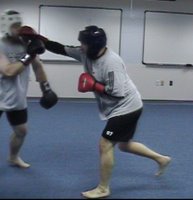 To determine how much is too much, ask yourself:
To determine how much is too much, ask yourself:
What is the purpose of the sparring session or drill?
What kind of protection is being worn?
The purpose of the drill or sparring session determines the appropriate level of contact. If I am teaching a beginner how to block a haymaker, I will destroy her confidence by throwning it with knockout force and intent. In that case, I should use no contact, then light, then, at a high level of confidence (for her), medium. When she has experience with sparring and hard drills, then progress to heavy contact for the purpose of a pre-arranged drill only, and with complete foreknowledge. Build up, don't destroy your students. Conversely, with a trained contact fighter, light contact may handicap or destroy his ability to deal with what he will face in the competitive arena or on the street - a full contact, MMA or kickboxing fighter should probably vary between medium and heavy contact, depending on the goal of the session.
Finally, the protective gear worn can make a big difference in what level of contact to use. When someone is wearing a complete RedMan outfit, or similar gear, the purpose of the drill and the gear makes heavy contact the desired level.
 Last, two warnings: Head contact is always potentially dangerous. Even with head protection and 16 oz. gloves, the brain still sloshes around, and is bruised by a heavy blow. I never recommend heavier than medium contact for sparring, only in drills or competition. Second, the headgear with a face mask is bogus! I have sparred with people wearing those, and all it does is extend the face out 3-4 inches and make it easier to hit them. I don't recommend it at all.
Last, two warnings: Head contact is always potentially dangerous. Even with head protection and 16 oz. gloves, the brain still sloshes around, and is bruised by a heavy blow. I never recommend heavier than medium contact for sparring, only in drills or competition. Second, the headgear with a face mask is bogus! I have sparred with people wearing those, and all it does is extend the face out 3-4 inches and make it easier to hit them. I don't recommend it at all.